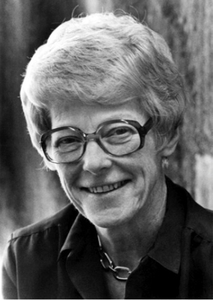Marian Koshland facts for kids
Quick facts for kids
Marian Koshland
|
|
|---|---|
 |
|
| Born |
Marian Elliott
October 25, 1921 |
| Died | October 28, 1997 (aged 76) |
| Nationality | American |
| Alma mater | Vassar College (B.S., 1942) University of Chicago (M.S., 1943; Ph.D., 1949) |
| Known for | Research into antibodies and immune response |
| Spouse(s) | Daniel E. Koshland Jr. (1920–2007) |
| Children | Ellen Koshland Phyllis Koshland James Koshland Gail Koshland Douglas Koshland |
| Parents |
|
| Awards | FASEB Excellence in Science Award (1989) |
| Scientific career | |
| Fields | Immunology, bacteriology |
| Institutions | University of California, Berkeley |
| Influences | Arne Tiselius, Elvin A. Kabat, Karl Landsteiner, David Baltimore |
Marian Elliott "Bunny" Koshland (October 25, 1921 – October 28, 1997) was a brilliant American scientist. She was an immunologist, which means she studied how our bodies fight off sickness. Marian made a super important discovery about how our bodies' defenders, called antibodies, work. She found out that tiny differences in these antibodies help them fight off all sorts of germs and invaders, keeping us healthy!
Contents
Early Life and Education
Marian Elliott was born on October 25, 1921, in New Haven, Connecticut. Her mother, Margrethe Schmidt Elliott, was a teacher from Denmark. Her father, Walter Elliott, was a hardware salesman.
When Marian was young, she was very adventurous. She loved exploring and was brave, even handling a large snake! She attended Vassar College in New York. In 1942, she earned her degree in bacteriology, which is the study of tiny living things like bacteria.
Advancing Her Scientific Studies
After Vassar, Marian went to the University of Chicago. She earned her Master of Science (M.S.) degree in bacteriology in 1943. While there, she worked on ways to stop the spread of breathing illnesses. She also helped a team develop a vaccine for cholera, a serious disease.
In Chicago, she met Daniel E. Koshland Jr., who was also a biochemist. They got married in 1946.
Working on the Manhattan Project
In 1945, Marian joined Daniel in Oak Ridge, Tennessee. She spent a year working on the Manhattan Project. This project was a secret research effort during World War II. Marian's part involved studying how radiation affects living things.
After this, Marian and Daniel moved back to Chicago. Marian earned her Doctor of Philosophy (Ph.D.) degree in immunology in 1949. This was a big achievement, especially since it was not always easy for women to pursue advanced degrees at that time.
Discovering Antibody Secrets
After getting her Ph.D., Marian continued her research. She spent two years at Harvard Medical School. Later, she and Daniel worked together at the Brookhaven National Laboratory for 13 years.
In the early 1950s, Marian Koshland showed that antibodies found in blood were different from those found in other body fluids. This was a key step in understanding how our immune system works.
Unlocking Antibody Specificity
By the 1960s, Marian focused on how antibodies become so specific. Imagine our bodies have millions of different keys (antibodies). Each key is designed to unlock only one specific lock (a germ or virus). Marian wanted to know how these keys were made so perfectly.
She carefully studied antibodies that fought different invaders. She found that these antibodies had different building blocks, called amino acids. This meant they had different structures. This discovery was very important. It helped scientists understand how our bodies create so many different antibodies to fight off countless threats. Her work was so impressive that when she first shared her findings, she received a standing ovation!
Career and Leadership
In 1965, Marian Koshland became a researcher at the University of California, Berkeley. She joined the faculty there in 1970. She continued her studies in molecular biology, which looks at life at a very tiny, molecular level.
From 1982 to 1989, she was the head of Berkeley's Department of Microbiology and Immunology. She also led the department's Graduate Affairs Division. Marian was a leader in the scientific community. She served on the board of the National Science Foundation. She was also president of the Council of American Association of Immunologists in 1982 and 1983.
In 1989, she received the first-ever FASEB Excellence in Science Award. This award recognized her outstanding contributions to science.
Legacy and Impact
Marian Koshland passed away in Berkeley, California, on October 28, 1997. She died from lung cancer.
Her work changed how we understand the immune system. She helped us see how our bodies create specific defenses against diseases.
Honoring Her Contributions
Two important places are named in her honor:
- The Marian Koshland Science Museum in Washington, D.C. This museum has exhibits that help everyone learn about science.
- The Marian E. Koshland Integrated Natural Science Center at Haverford College. This center houses the science departments at the college.
Marian's children, Catherine Koshland and Douglas Koshland, both attended Haverford College. They also hold important positions at U.C. Berkeley, continuing their family's connection to science and education.
Images for kids


